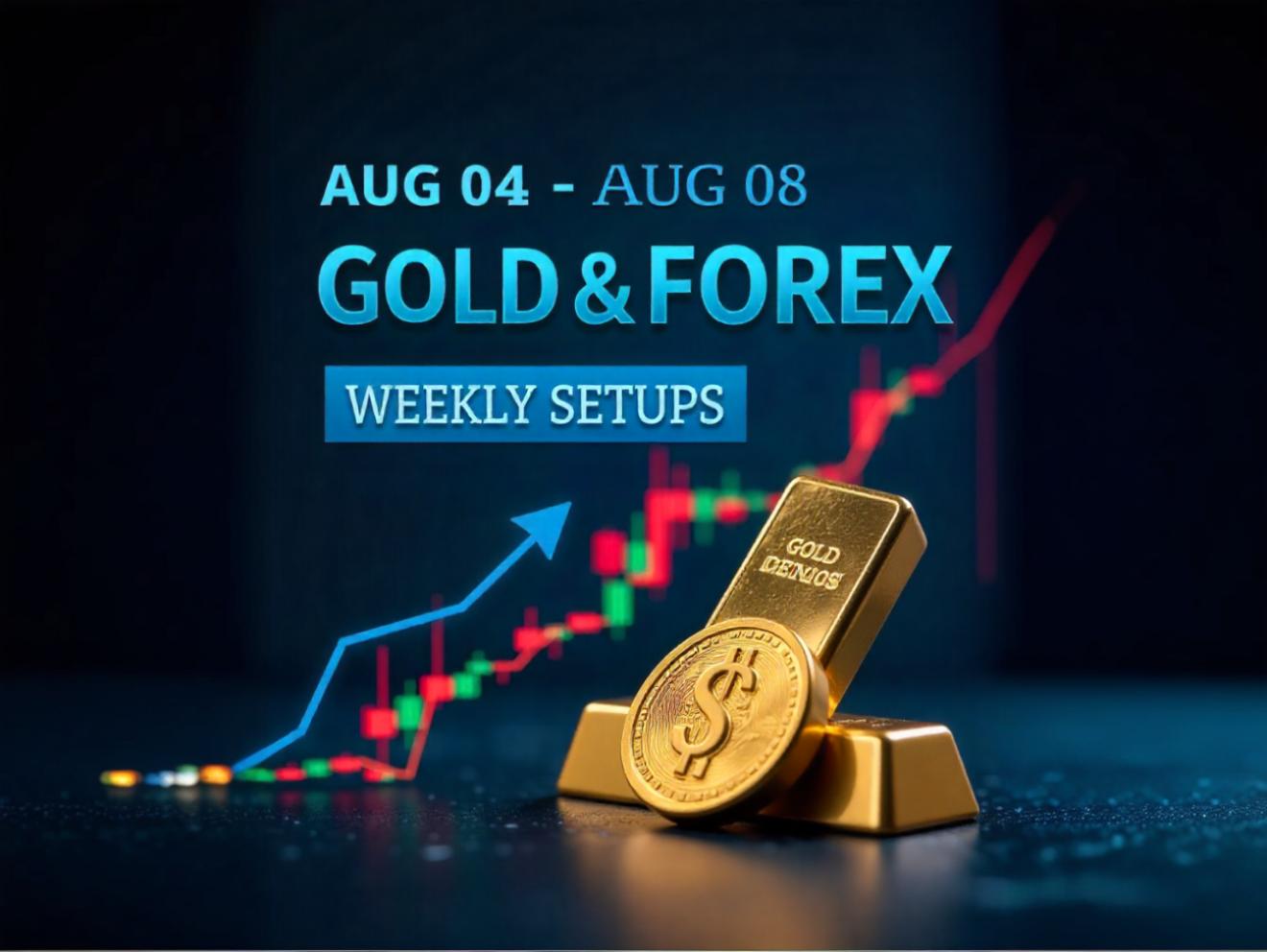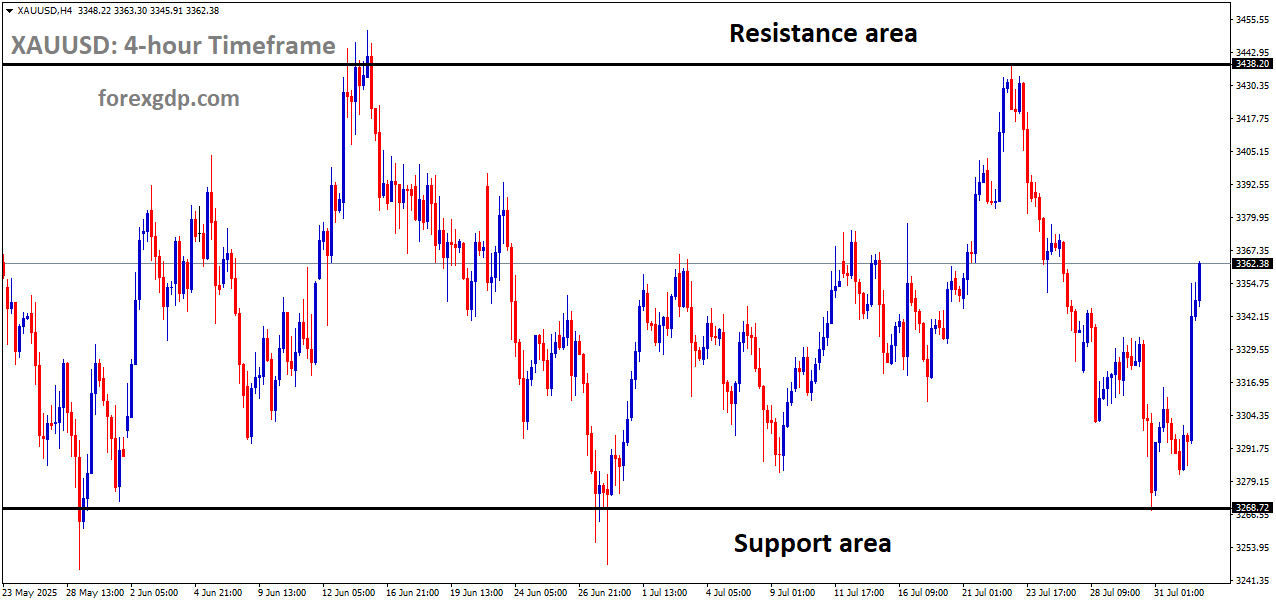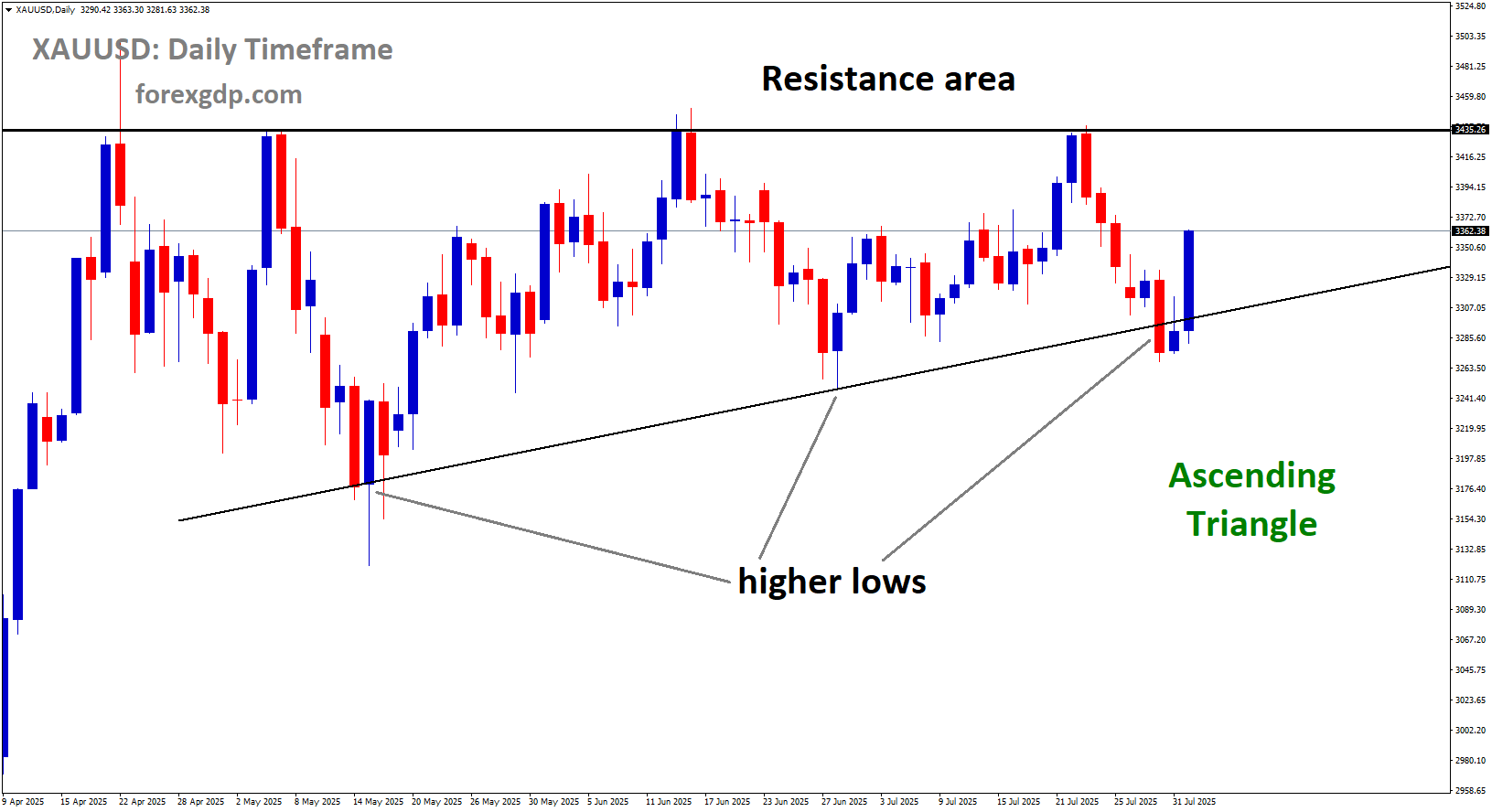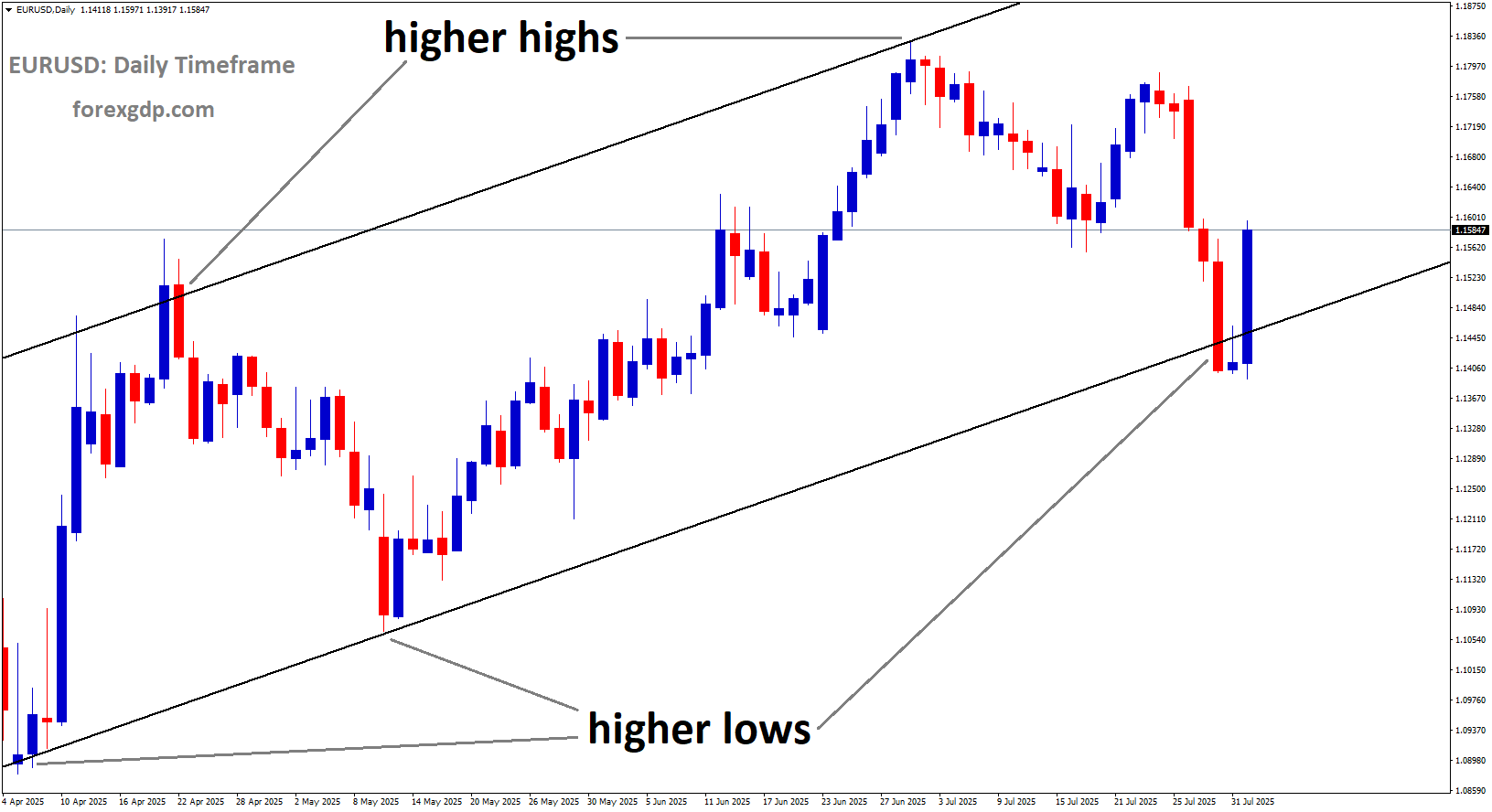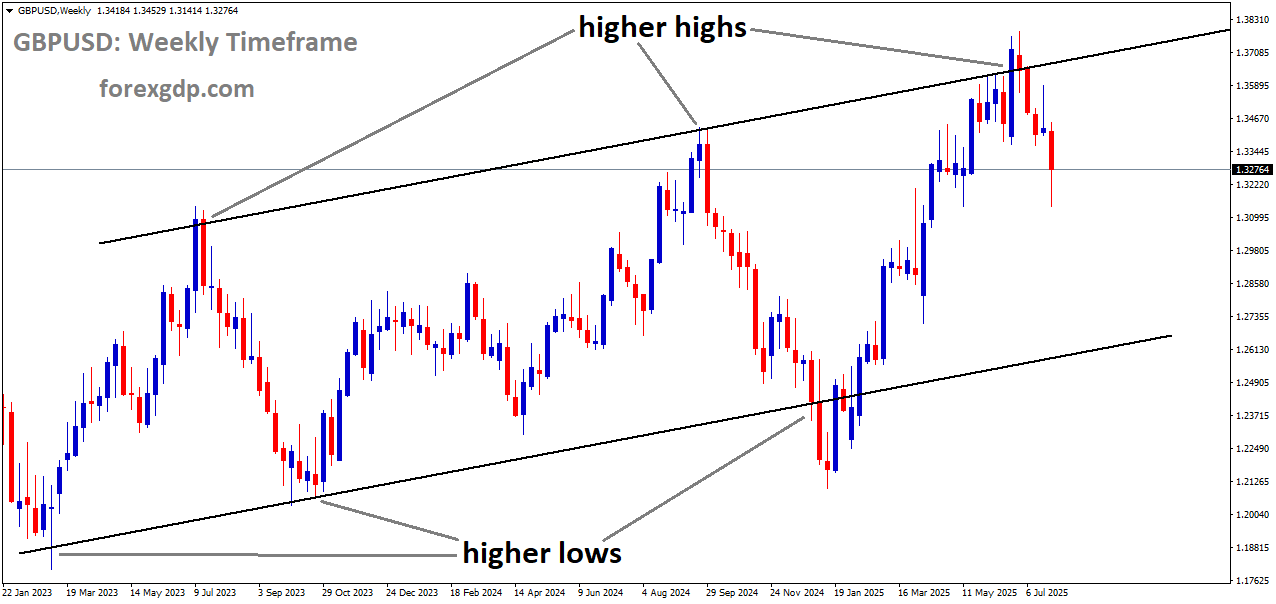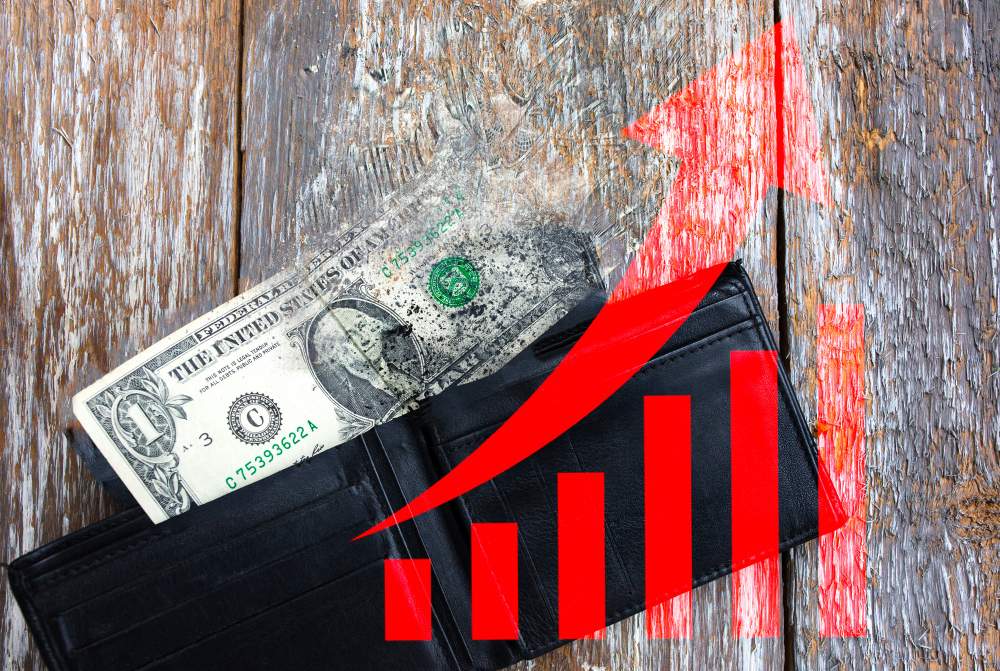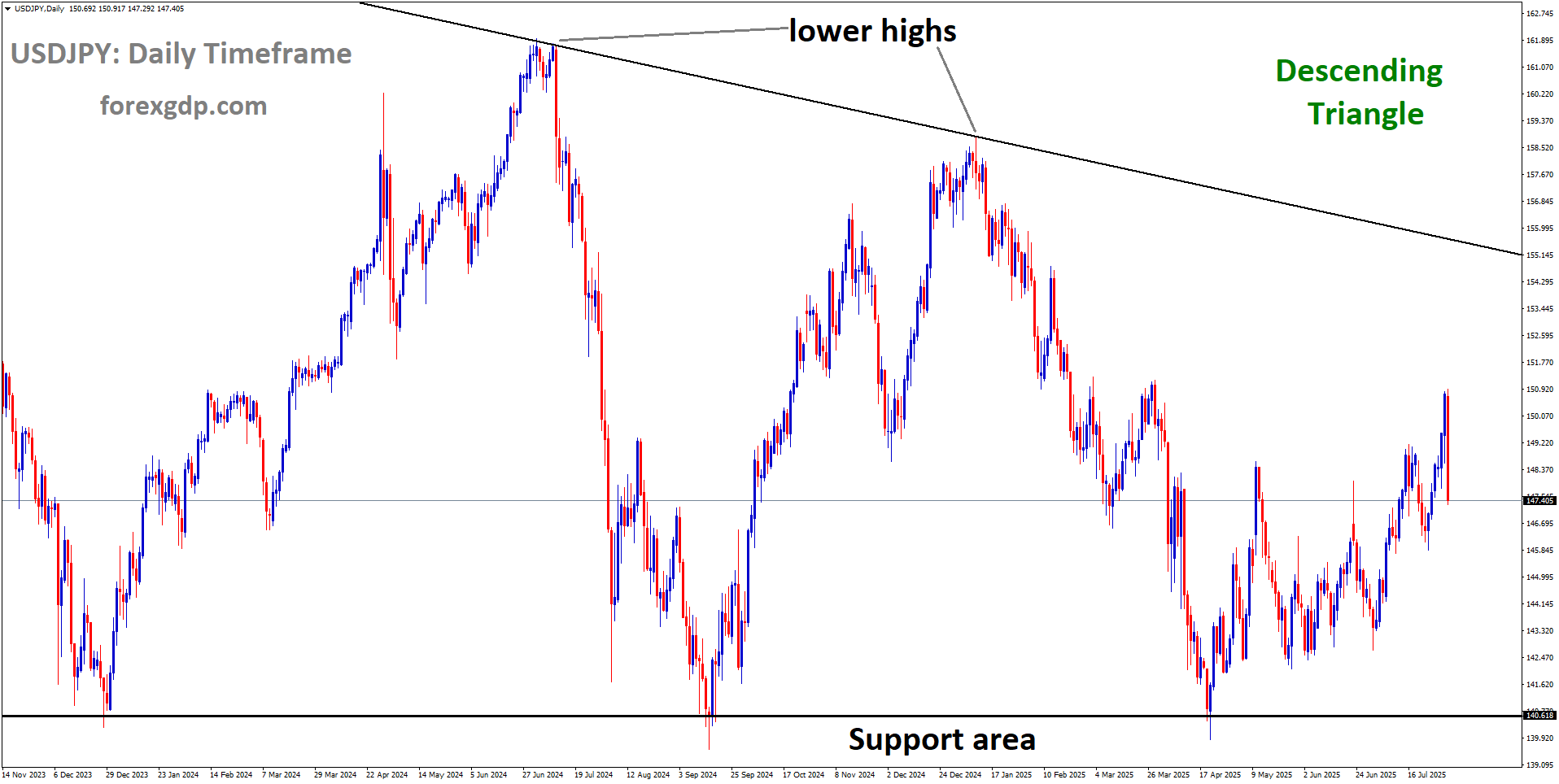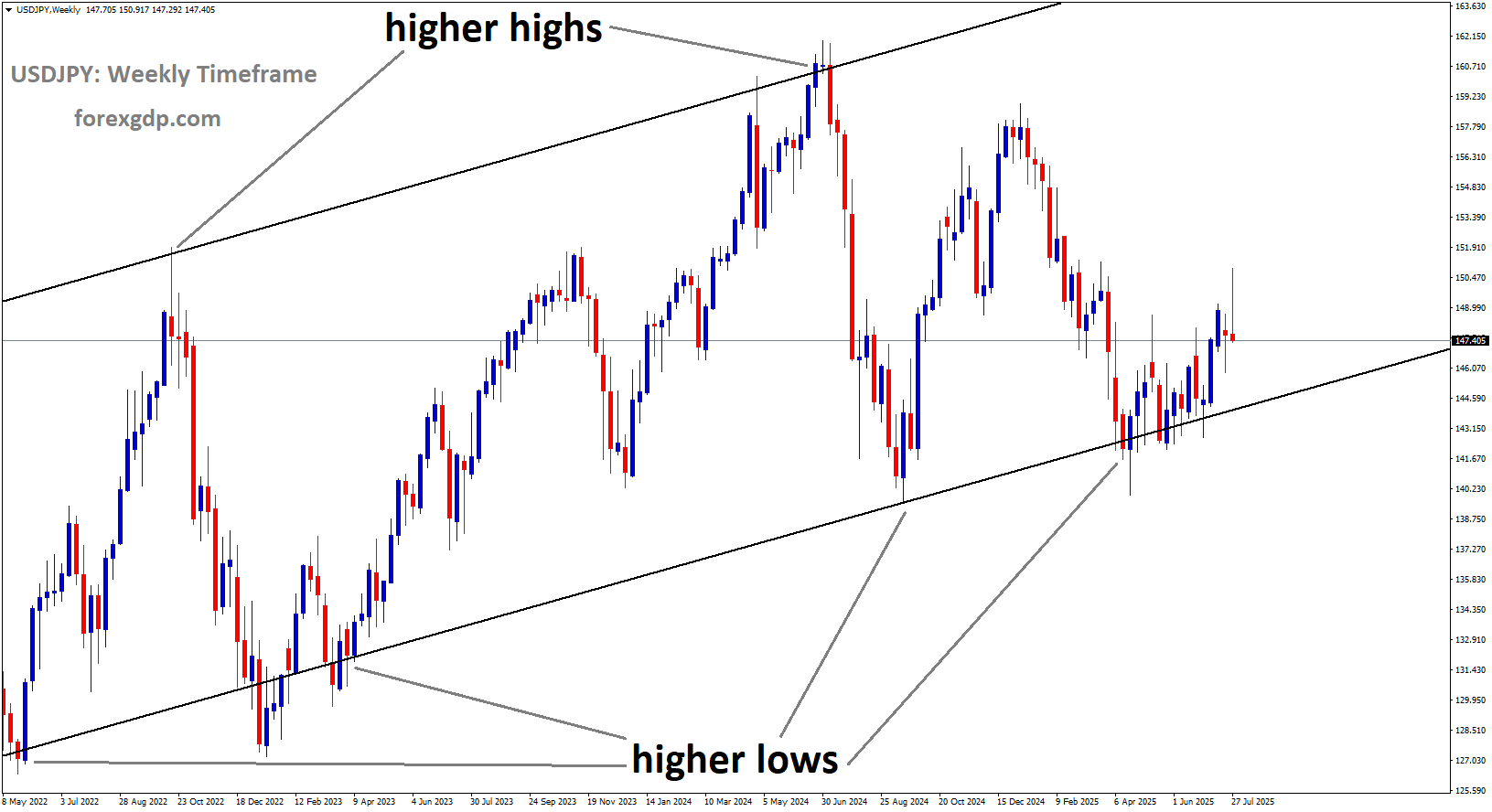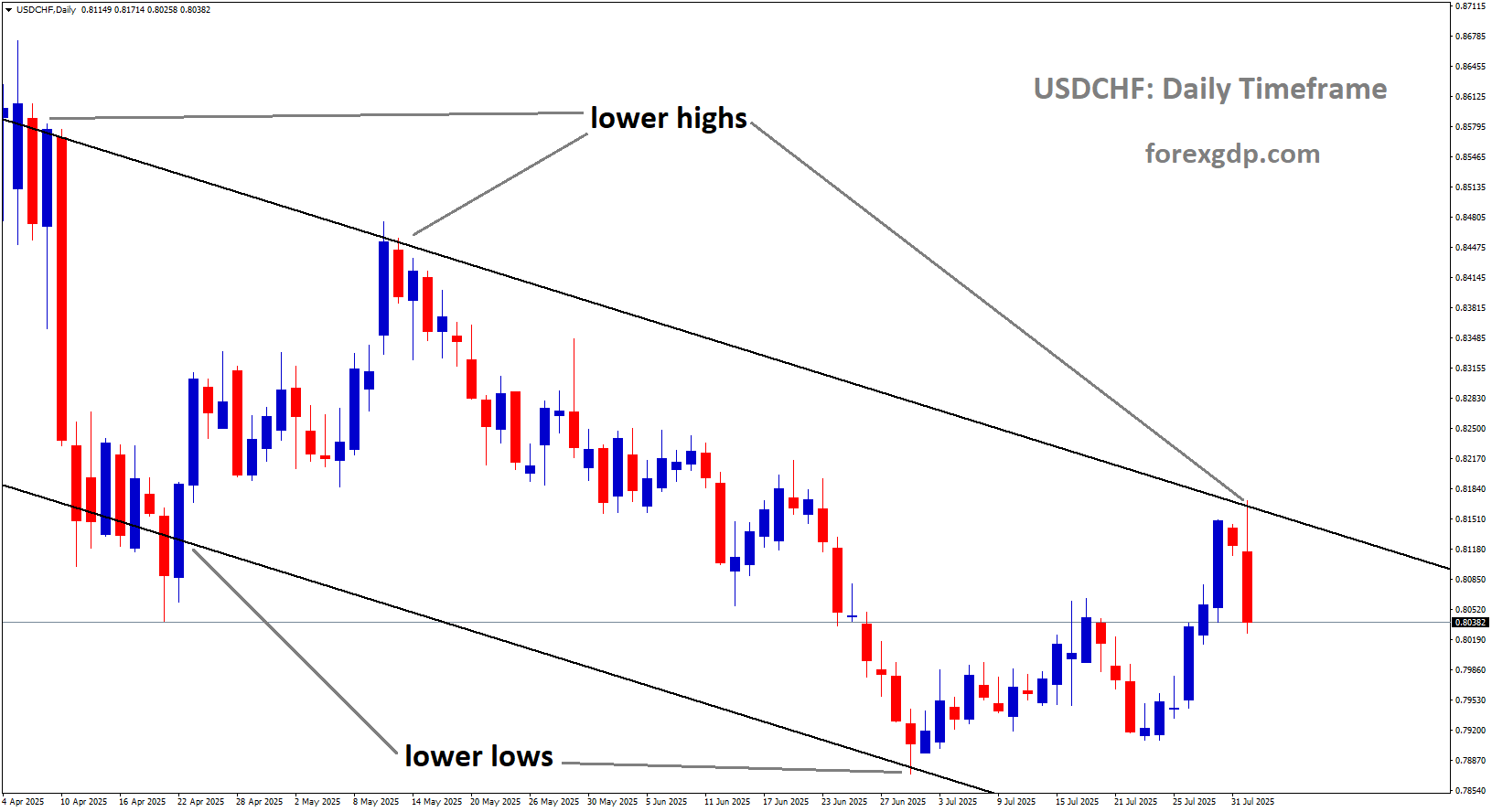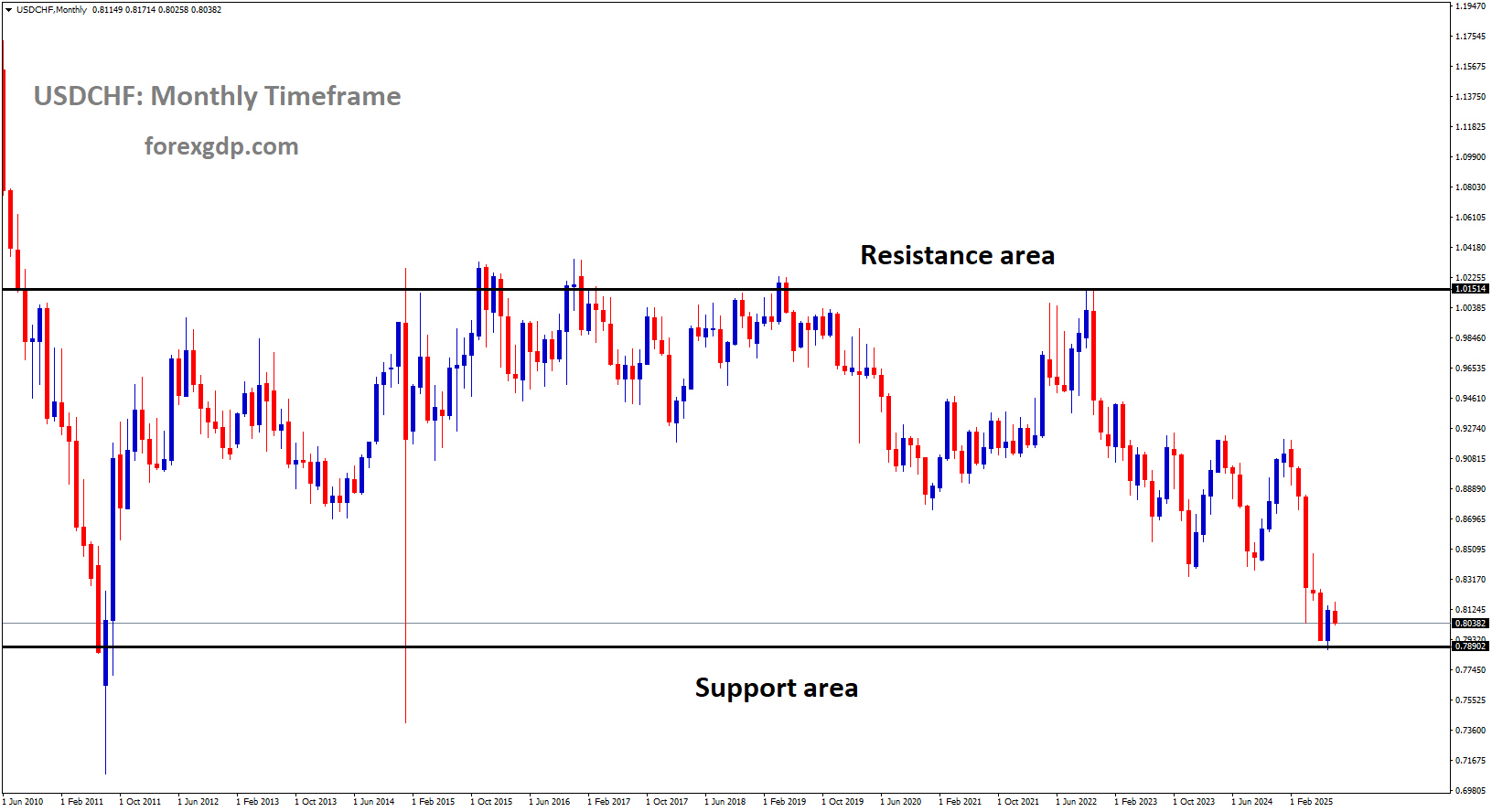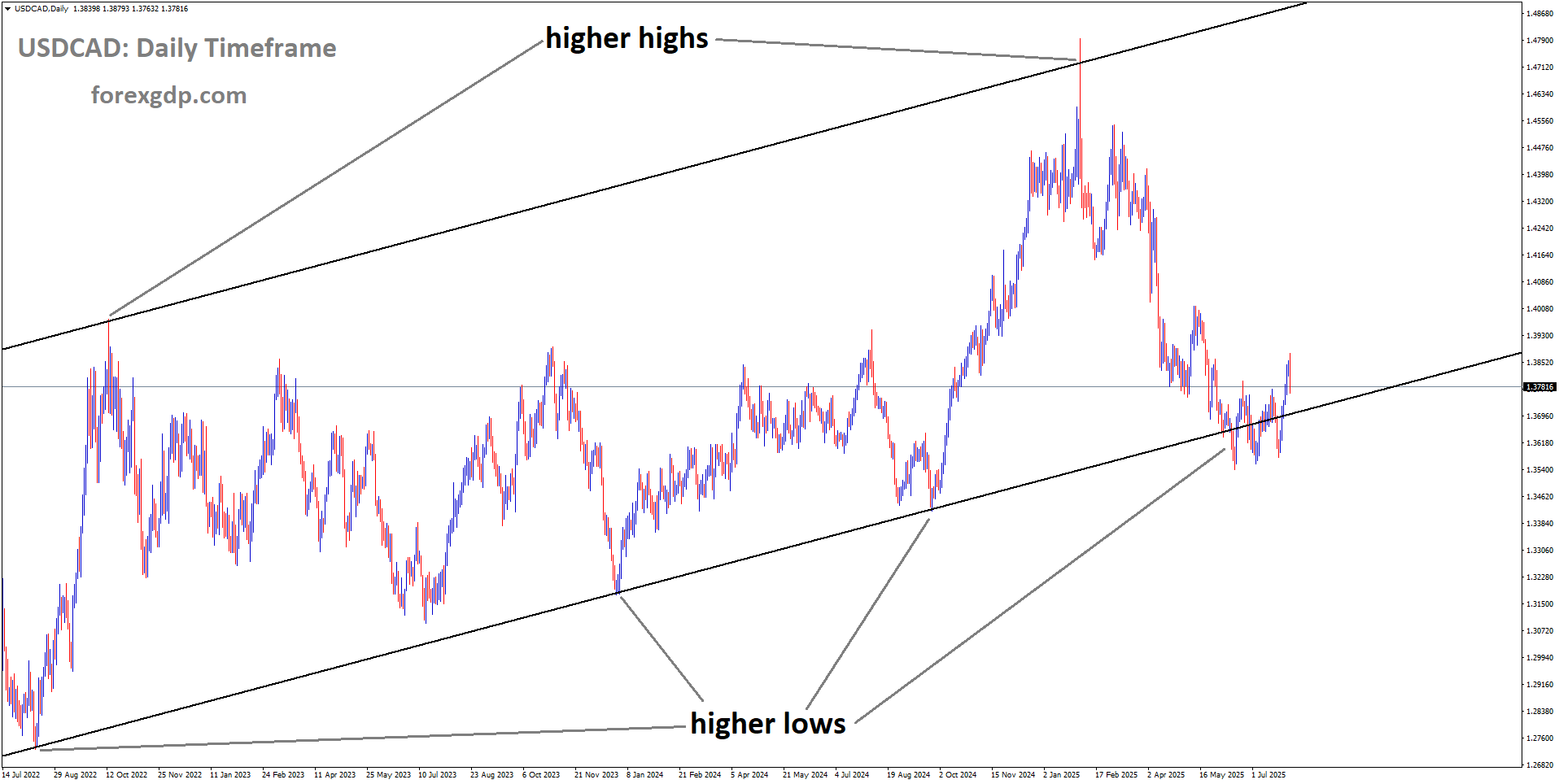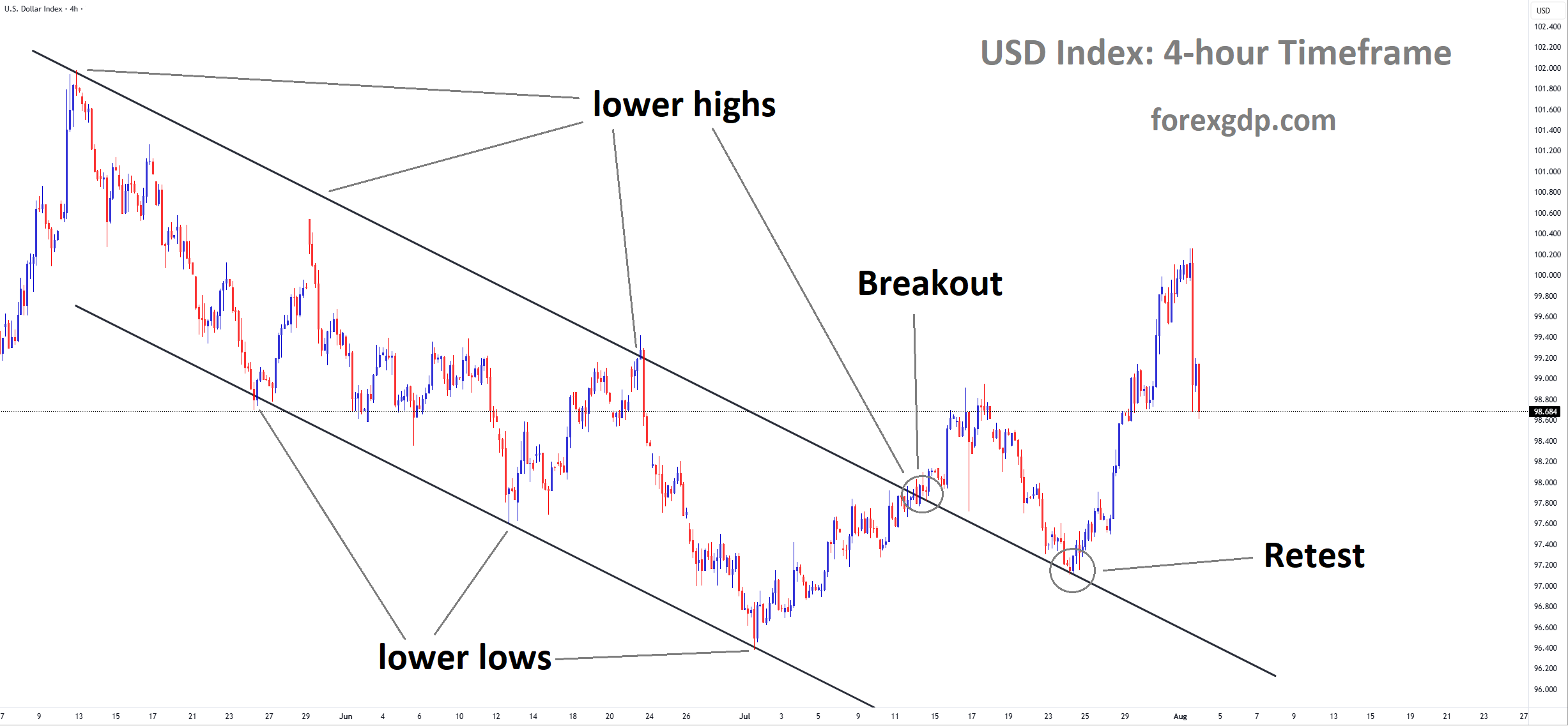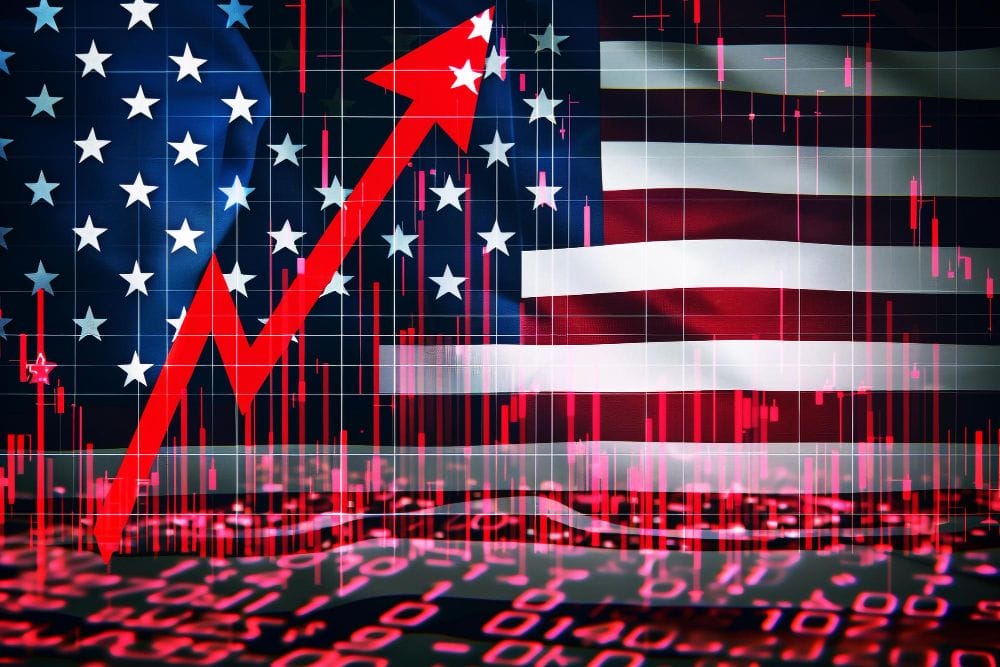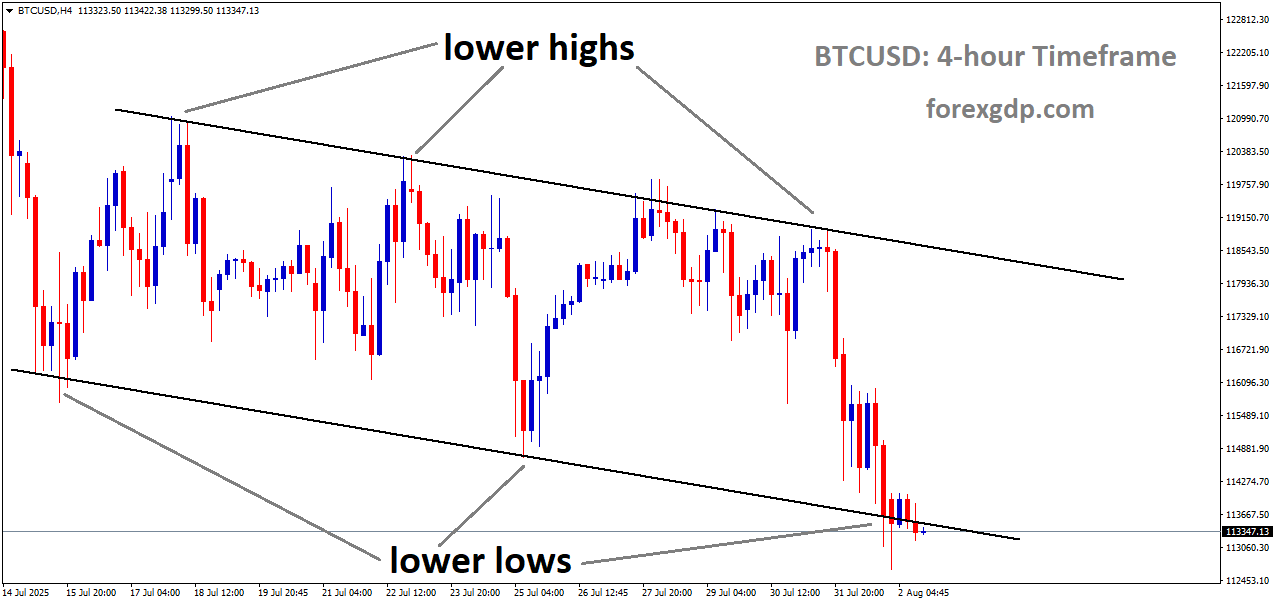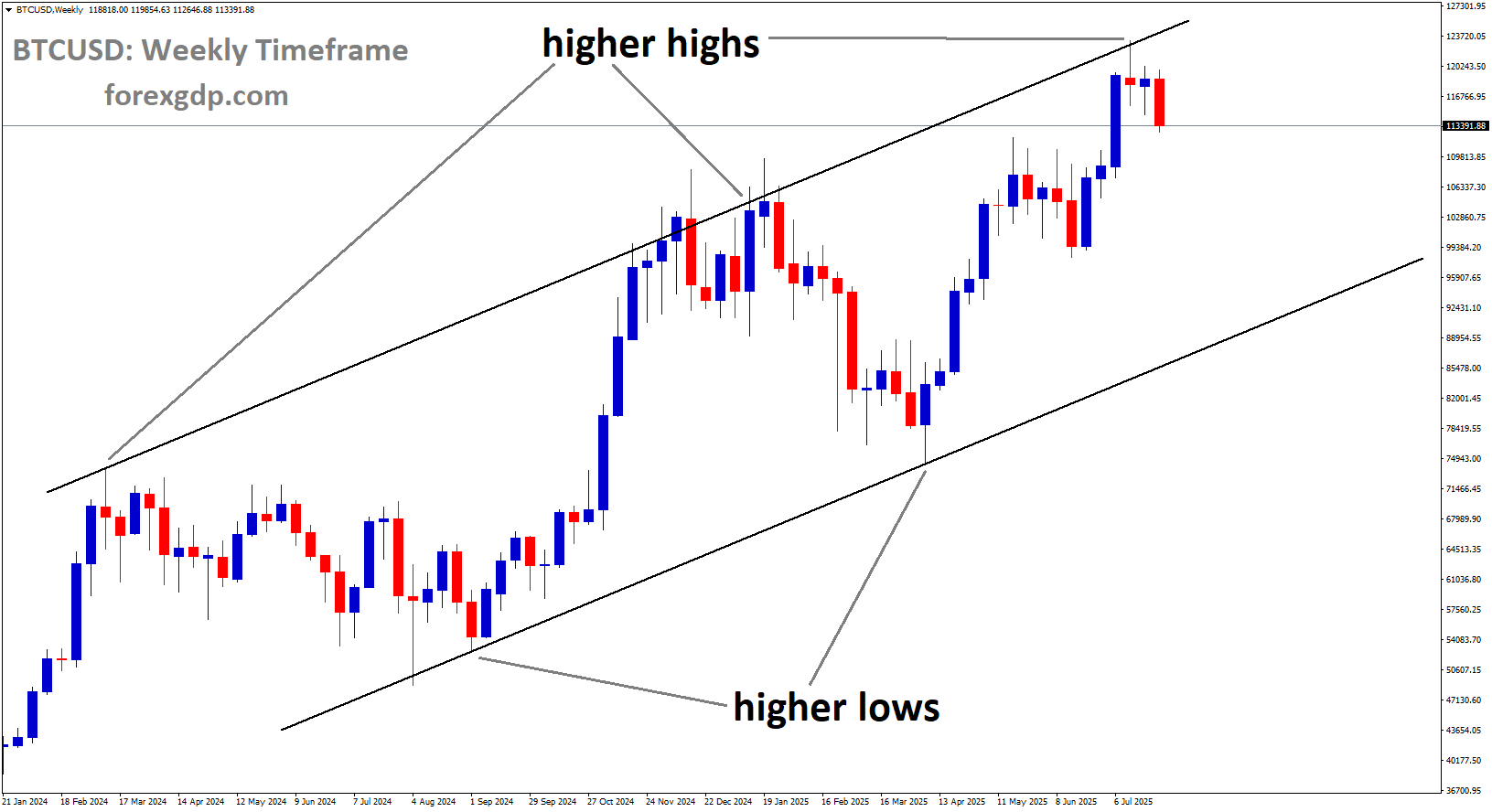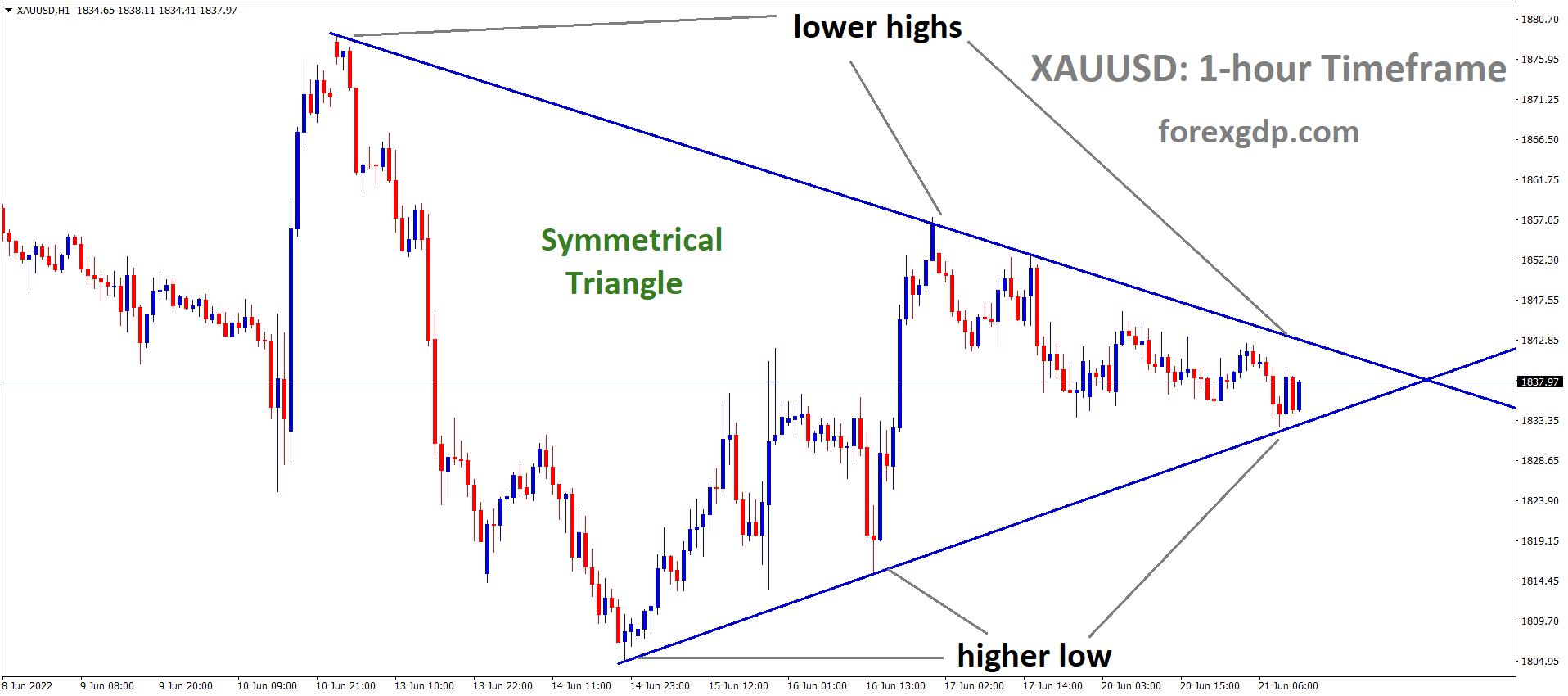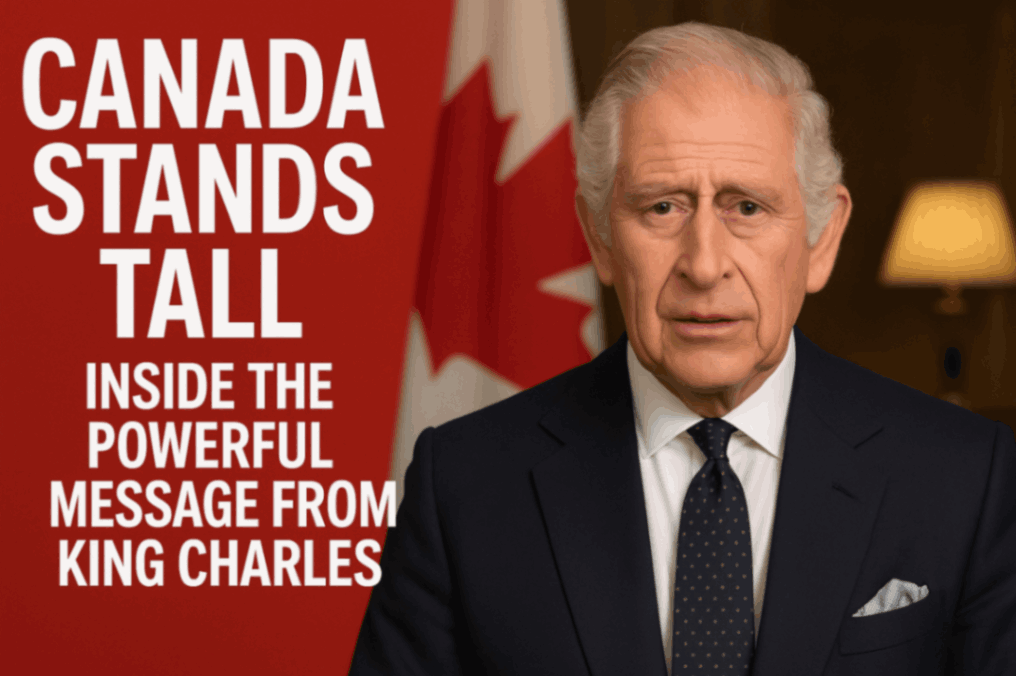XAUUSD Surges as Global Tensions and Job Market Slump Fuel Gold Rally
When gold starts grabbing headlines, it’s usually a sign that something big is going on in the world. And right now? There’s a lot happening. Recently, gold prices have surged, and it’s not just because of demand—it’s about fear, uncertainty, and a changing economy.
Let’s walk through what’s really going on behind the scenes and why people are once again turning to gold as their safe haven.
The Job Market Shock That Caught Everyone Off Guard
So, here’s where it all started: the U.S. jobs report for July came out, and… let’s just say it wasn’t pretty.
Only 73,000 new jobs were added in July. To put that into perspective, most analysts were expecting at least 110,000. That’s a huge miss, and it’s got people worried. When fewer jobs are created, it often signals that the economy is slowing down.
But it doesn’t end there.
XAUUSD is moving in a box pattern, and the market has rebounded from the support area of the pattern
Previous months’ job numbers for May and June were also quietly revised—and not in a good way. Nearly 258,000 jobs that were originally reported just vanished from the books. That kind of correction isn’t normal and shows the job market might be much weaker than we thought.
This kind of data makes investors nervous. It makes regular people nervous too. And that’s when gold starts to shine. Why? Because when the future feels uncertain, gold feels safe.
Why The Fed Might Be Changing Its Tune
One of the biggest ripple effects from weak jobs data is how it impacts the Federal Reserve’s thinking.
Now, the Fed’s job is to keep inflation in check and make sure the economy doesn’t overheat—or freeze. When the job market looks strong, they typically raise interest rates to keep things balanced. But when data like this comes in? That’s a different story.
Right after the weak jobs report, many on Wall Street began expecting the Fed to cut interest rates soon. In fact, there’s now a 76% chance that the Fed will cut rates by 25 basis points in its next big meeting.
What does this have to do with gold?
A lot, actually. When interest rates fall, the return you get from things like bonds also drops. That makes non-yielding assets like gold more attractive. No interest? No problem—at least when gold offers a safety net during rough patches.
It’s Not Just About Jobs: There’s A Bigger Picture
Sure, the job report was bad—but that’s only part of the puzzle.
There are other signs pointing to a broader slowdown. For example:
-
Manufacturing in the U.S. is still struggling. The latest data from the Institute for Supply Management (ISM) shows that the sector is still in a recessionary zone. Manufacturing jobs and activity haven’t bounced back the way many hoped they would.
-
Consumer sentiment isn’t looking great either. The University of Michigan’s Consumer Sentiment Index—a popular way to track how everyday Americans feel about the economy—slipped again. People are still spending, but confidence is fragile.
-
Long-term inflation fears are calming down. Households now expect inflation to settle lower over the next five years. That’s not necessarily bad, but it means people believe the economy might cool down too much.
When you put all these pieces together—slower job growth, weak manufacturing, and shaky consumer confidence—it paints a picture of an economy that’s losing steam. And that’s the kind of scenario where gold starts to feel like the right bet.
Global Tensions Add More Fire to Gold’s Appeal
Let’s not forget about what’s happening around the world. Geopolitics always plays a role in gold’s behavior.
Lately, tensions between the U.S. and Russia have been heating up again. Things got even more intense when former President Donald Trump sent nuclear submarines to strategic areas in response to Russian statements that suggested the U.S. was pushing too hard for a resolution in Ukraine.
While that may sound like a political chess game, it sends a loud message to global investors: things are far from stable.
And in uncertain global environments, gold becomes a go-to safe-haven. It doesn’t rely on any one country’s currency or political decisions. It’s just… gold. Tangible, finite, and trusted.
What Investors Are Thinking Right Now
So, what’s the reaction from big investors and traders?
Well, the mood has shifted. Instead of expecting more rate hikes or a booming economy, people are preparing for a slower pace—and maybe even a few bumps in the road.
You can see this in Treasury yields, which have dropped across the board. Yields fall when demand rises, which often happens when investors flee riskier assets. That’s exactly what’s happening now.
XAUUSD is moving in an ascending triangle pattern, and the market has rebounded from the higher low area of the channel
And while some Fed officials are still taking a cautious approach, even they’ve acknowledged that the labor market is slowing. The Cleveland Fed’s Beth Hammack, for instance, called the recent jobs report “disappointing,” though she insists the market is still balanced overall. Others, like Atlanta Fed’s Raphael Bostic, have started sounding more open to rate cuts, despite lingering inflation worries.
In short: the markets are shifting. And gold is benefiting.
Final Summary: Why Gold is Back in the Spotlight
Gold’s recent rally isn’t just a blip. It’s the result of a perfect storm of economic red flags and growing global uncertainty.
With the U.S. job market showing real signs of fatigue, the Fed is now under pressure to shift gears. Manufacturing is still stuck in low gear, consumer confidence is shaky, and inflation expectations are cooling down. Add in renewed geopolitical tension, and it’s clear why so many are turning to gold for protection.
This isn’t about technical patterns or price levels—it’s about real-world events shaping how people feel about risk. And when fear takes over, gold becomes more than just a shiny metal—it becomes a trusted refuge.
Whether you’re a seasoned investor or just trying to understand what’s going on, one thing is clear: gold is back in the spotlight, and it might stay there for a while.
EURUSD Breaks Higher Following U.S. Hiring Slump and Fed Speculation
When markets move fast, there’s usually a story behind the scenes that explains all the action. One such shift happened recently with the EUR/USD currency pair, where the euro jumped significantly against the US dollar. If you’re wondering what caused this sudden excitement, stick around—we’re breaking it all down in a way that actually makes sense.
EURUSD is moving in an Ascending channel, and the market has rebounded from the higher low area of the channel
Let’s dive into the key reasons why the euro gained strength and why the US dollar stumbled, without throwing you into a sea of technical jargon or price charts.
US Jobs Report Triggers Market Jitters
So, what really set things off?
It all started with a surprisingly weak US jobs report. Every month, economists and traders wait anxiously for the Nonfarm Payroll (NFP) numbers. This report tells us how many jobs were added in the previous month (excluding farming jobs, hence the name).
For July, the report was disappointing. Instead of the expected job growth, only 73,000 new jobs were added. That’s a big miss—especially when compared to the revised figures from May and June, which were also cut by a whopping 258,000 jobs combined. Ouch.
And when job numbers come in that low, investors start to worry. It suggests that the US economy might be losing steam faster than expected. This immediately sparked talk about interest rate cuts.
Interest Rates on the Chopping Block?
Here’s where things get interesting.
Before the jobs data came out, markets were pricing in some small rate cuts by the Federal Reserve (Fed) later this year. But after seeing how bad the jobs report was, traders started pricing in much deeper cuts—as much as 62 basis points by December.
Why does that matter? Well, when interest rates go down, the value of a country’s currency usually follows. Lower rates mean lower returns for investors holding that currency, making it less attractive. And that’s exactly what happened with the US dollar—it lost ground quickly.
According to market odds, there’s now about a 76% chance that the Fed will cut rates at their September meeting. That’s a major shift in sentiment, and it played a big role in the dollar’s drop.
European Inflation Surprises to the Upside
While the US was dealing with gloomy data, things in the Eurozone looked a bit more stable—at least on the inflation front.
The European Union released its July inflation numbers, and they came in stronger than expected. The Harmonized Index of Consumer Prices (HICP) showed a 2.4% year-over-year increase, while the core inflation number (which strips out food and energy) held steady at 2.0%. That’s a sign that inflation in Europe is still hanging around, even if it’s not running wild.
Why does this matter?
Because if inflation remains sticky, the European Central Bank (ECB) might delay or even avoid cutting interest rates. And if the ECB holds steady while the Fed starts slashing rates, it makes the euro more attractive by comparison.
In simple terms: Europe looks steady, the US looks shaky, and that’s why investors are moving their money toward the euro.
A Mixed Bag of US Economic Data Adds to the Pressure
It wasn’t just the jobs report dragging the US dollar down. There was a whole list of other economic indicators that didn’t do the greenback any favors.
Manufacturing Slowdown Deepens
The Institute for Supply Management (ISM) released its July data, showing that US manufacturing activity continued to shrink. The manufacturing index dropped to 48.0, marking the fifth month in a row that the sector has been in contraction.
This tells us that businesses are pulling back, production is slowing, and confidence in the broader economy is starting to fade. The weak employment numbers in the manufacturing sector only added fuel to the fire.
Consumer Sentiment: Not So Rosy
Even consumer sentiment—a key gauge of how Americans are feeling about the economy—took a hit.
The University of Michigan’s Consumer Sentiment Index came in slightly lower than expected at 61.7. While it was technically an improvement over the previous month, it still suggests that households are feeling cautious, especially with inflation expectations ticking slightly higher for the near term.
Put all of this together and you get a picture of an economy that’s not falling apart, but definitely starting to wobble. And in the world of forex, uncertainty tends to push investors toward safer or more promising alternatives.
Fed Officials Weigh In: One Cut or Two?
After the weak job numbers came out, several Federal Reserve officials stepped forward to offer their views.
-
Cleveland Fed President Beth Hammack called the jobs report “disappointing” but still believed the labor market was relatively balanced. She supported the Fed’s decision to hold rates steady for now.
-
Atlanta Fed President Raphael Bostic, on the other hand, said the labor market was clearly slowing and acknowledged inflation was still a bigger concern. He said he still expects just one rate cut, keeping his tone more cautious.
These mixed messages reflect the divided outlook within the Fed. Some officials are more concerned about inflation, while others are worried about growth. Either way, it adds a layer of uncertainty to the Fed’s next move—and uncertainty usually means volatility in the markets.
Europe’s Momentum Isn’t Perfect, But It’s Enough
Let’s not pretend everything in Europe is perfect. Some data from the Eurozone showed signs of struggle—especially in Germany and France, where manufacturing activity continued to shrink. But on the whole, the bloc held up better than expected.
The Manufacturing PMI for the Euro area saw improvements in places like Spain and Italy, even if the broader sector is still facing challenges. And more importantly, the inflation data signals that the ECB might be able to hold the line a little longer.
For currency traders, that’s all the excuse they needed to move into euros and dump the dollar.
The Bigger Picture: What This All Means for You
Whether you’re a casual investor, a trader, or just someone trying to understand the world economy, here’s the key takeaway:
-
The euro is strengthening, largely because the US economy looks weaker and the Fed is expected to cut interest rates soon.
-
Meanwhile, Europe’s economic data, especially on inflation, looks just solid enough to keep the ECB from rushing into rate cuts.
-
This widening gap in monetary policy expectations is creating a shift in currency values, especially for the EUR/USD pair.
Final Summary: What’s Next for the Market Mood?
The recent surge in the euro and drop in the dollar is a clear sign of how quickly market sentiment can change. A single weak jobs report, combined with soft manufacturing numbers and lukewarm consumer sentiment, was enough to tilt expectations for US interest rates—and that had ripple effects across the entire forex market.
For now, the euro seems to have the upper hand. But keep in mind, these trends can shift just as fast as they appeared. Upcoming economic reports, especially around inflation and employment, will continue to drive the narrative.
So, while things may seem to favor Europe at the moment, all eyes will be on the next set of data to see whether this momentum holds—or flips once again.
GBPUSD Dips Deeper as Market Focus Shifts to US Jobs Data
If you’ve been following the currency markets lately, you might have noticed the British Pound has been taking a bit of a tumble. Specifically, it’s been weakening against the US Dollar—and there are a few reasons why this is happening. But don’t worry, we’re going to break it all down in plain and simple terms. Let’s dive into the key factors driving the Pound lower and what it might mean going forward.
Fed Uncertainty Is Giving the Dollar a Boost
When it comes to global currencies, the US Dollar plays a major role. It’s often viewed as a safe bet during times of economic uncertainty. Recently, investors have been changing their minds about what the Federal Reserve (that’s the US central bank) is going to do with interest rates. And that’s making the Dollar stronger.
GBPUSD is moving in an Ascending channel, and the market has fallen from the higher high area of the channel
No More Confident Bets on Rate Cuts
A short while ago, traders thought the Fed would cut interest rates soon—maybe as early as September. But now? Not so much. The odds of a rate cut have dropped significantly, all thanks to stronger-than-expected economic data coming out of the United States.
-
The US economy grew faster than predicted in the second quarter.
-
Inflation, based on something called the “core PCE index,” stayed stubbornly high.
-
Fed Chair Jerome Powell made it clear: they’re in no rush to cut rates.
All of this has made investors rethink their positions. They’re now less confident about a rate cut happening soon, and that’s pushing the Dollar up while dragging the Pound down.
Why the Bank of England Is Under Pressure
Now let’s look at what’s happening on the UK side of things. The Bank of England (BoE), which is in charge of setting interest rates in the UK, is facing a different kind of problem—slowing growth and persistent inflation.
Eyes on the Upcoming Interest Rate Decision
Everyone’s waiting to see what the BoE decides in its next meeting. And the general expectation? A rate cut might be on the table. Many experts believe the BoE could reduce rates by 0.25%, which would mark the first cut in this cycle.
Why would they do that?
-
Inflation has been falling, but not fast enough.
-
Economic growth is showing signs of weakness.
-
Household spending and business investment are slowing down.
Still, inflation in the UK is not yet back to the 2% target, and some projections say it might stay above that level for at least a couple more years. Because of this, the Bank might only go for a small cut and then wait to see how things unfold. That’s why analysts are calling it a “one-and-done” move—cut once, and then hit pause.
What the Upcoming US Jobs Report Could Mean
The currency market also has its eyes on a major economic report coming from the US—the Nonfarm Payrolls (NFP) data. This report shows how many jobs were added to the US economy in a given month, and it’s a big deal for investors.
Jobs Data Could Shift Market Sentiment Again
Here’s the deal: if the report shows strong job growth, it’ll give the Fed even more reason to keep interest rates steady. On the other hand, if the numbers disappoint, it might open the door for rate cuts later in the year.
What’s expected?
-
Around 110,000 new jobs are predicted to be added.
-
That’s less than the 147,000 jobs added the previous month.
-
Unemployment might inch up slightly.
Even though Fed Chair Powell recently warned about possible risks to the job market, things still seem fairly stable overall. If the job numbers come in as expected—or stronger—the US Dollar could continue climbing, putting more pressure on the Pound.
Other Economic Reports to Watch
Aside from the jobs report, there’s also the ISM Manufacturing PMI report coming out. While it may not get as many headlines, it still plays a role in shaping investor expectations.
This report shows how the US manufacturing sector is doing. If factories are shrinking, it could hint at economic slowdown. But if the decline is softening, it might suggest the economy is holding up just fine. Right now, predictions suggest a slight improvement, which again supports a stronger Dollar outlook.
What It All Means for the Pound
So, when you put all these puzzle pieces together—strong US economic data, reduced chances of Fed rate cuts, potential rate cuts in the UK, and cautious signals from the BoE—it makes sense that the Pound is struggling against the Dollar.
Currency values don’t move in a vacuum. They’re a reflection of economic confidence, interest rate expectations, and investor sentiment. And right now, the US is ticking more of those boxes than the UK.
Final Summary: A Shifting Tide in Currency Confidence
The recent drop in the Pound against the US Dollar isn’t just about numbers on a screen—it’s about changing expectations, shifting economic signals, and the way global investors respond to uncertainty. As the US shows signs of economic resilience and the UK faces lingering inflation concerns, we’re seeing a clear tug-of-war play out in the currency markets.
If the Bank of England does decide to cut rates next week, it might mark a turning point. But with the US showing fewer signs of easing up on monetary policy, the Pound could continue to face headwinds.
It’s a reminder that in the world of forex, timing and perception matter just as much as actual data. So if you’re keeping an eye on GBP/USD, stay tuned—this story is far from over.
USDJPY Tumbles as Disappointing US Jobs Report Shakes Market Confidence
If you’ve been watching the USD/JPY movement lately, you might’ve noticed something dramatic happened on Friday. The pair tumbled quite a bit during the American session—and if you’re wondering why, the answer lies in the latest US jobs data, also known as the Nonfarm Payrolls (NFP) report. But don’t worry, we’re going to break everything down in plain and simple terms without throwing technical jargon at you.
Let’s dig into what really caused this drop and why it’s such a big deal.
USDJPY is moving in a descending triangle pattern
What Happened With USD/JPY on Friday?
The USD/JPY currency pair fell hard on Friday, and the reason behind it is tied directly to the US employment report for July. It was a bit of a disappointment—and that’s putting it lightly.
Here’s what you need to know:
-
The US economy added only 73,000 jobs in July.
-
Markets were expecting something closer to 110,000 new jobs.
-
But that’s not all. The previous numbers for May and June were revised downward—and not by a little.
So what does this all mean? Well, investors were expecting a stronger labor market, and this weak number sent a pretty clear message: the US job market might be cooling off more than expected.
This kind of news tends to shake up the forex market, especially when it comes to the US Dollar.
How Did the Market React to the NFP Report?
A Blow to the Dollar’s Confidence
Whenever a major report like NFP underperforms, it instantly changes how traders feel about the strength of the US economy. In this case, the report didn’t just fall short—it was also accompanied by sharp downward revisions to the previous two months.
That revision basically means the US added 258,000 fewer jobs than originally reported for May and June combined.
To put that in perspective: imagine a sports team thinking they won 3 games last month, only to find out they actually lost all of them. That’s the kind of surprise the market felt.
Because of this shock, the US Dollar took a hit. When confidence in the economy drops, so does demand for the currency. Traders began pulling out of the Dollar, and that’s how USD/JPY started slipping.
Why Does the Jobs Report Matter So Much?
You might be wondering, “Why does one jobs report cause so much chaos in the forex market?” Good question.
The Nonfarm Payrolls report is a huge deal for several reasons:
-
It reflects the health of the US economy. When businesses are hiring, it shows that things are growing. But when job growth slows down, it raises red flags about economic strength.
-
It influences interest rate decisions. The Federal Reserve watches employment numbers closely. Weak job growth could lead the Fed to pause rate hikes—or even consider cuts in the future. That’s important because interest rates directly impact a currency’s value.
-
It shakes investor sentiment. Traders and institutions adjust their strategies quickly based on how strong or weak the economy appears. The NFP report gives them one of the clearest signals.
So when the July report came in far weaker than expected—and also revised previous months lower—it triggered a fast and strong reaction.
What Else Happened That Day?
Later that same day, traders were also waiting for another report from the Institute for Supply Management (ISM)—specifically the Manufacturing PMI data for July. While the ISM report is also important, all the attention was locked on the NFP numbers earlier in the session.
The damage was already done. The weak jobs report stole the spotlight and drove most of the market movement.
The Bigger Picture: What Could Happen Next?
While this drop in USD/JPY was significant, it’s important to understand the broader implications. It’s not just about one pair—it’s about what this data says about the future of the US economy.
Let’s take a quick look at what this could mean going forward:
-
Rate expectations may shift. If more economic reports show similar weakness, the Federal Reserve could delay any plans for rate hikes. Lower rates tend to weaken the Dollar further.
-
Market confidence might wobble. The job market is one of the pillars of economic stability. If cracks begin to show, other parts of the economy might slow down too.
-
Other currencies may gain strength. When the US Dollar weakens, other currencies—like the Japanese Yen—often become more attractive by comparison. That’s exactly what we saw here.
USDJPY is moving in an uptrend channel
For traders, analysts, and everyday investors, this kind of data changes the playbook. It’s not just about how the Dollar moves today, but what it might do in the weeks to come.
Final Summary
To wrap it up, the sharp drop in USD/JPY on Friday was all about disappointment in the US jobs data. With only 73,000 new jobs added in July—far below expectations—and downward revisions to the previous months, the market quickly lost confidence in the strength of the US labor market.
That loss of confidence triggered a chain reaction:
-
The US Dollar weakened,
-
Traders moved out of USD/JPY positions,
-
And the Japanese Yen gained ground as a result.
This just goes to show how one piece of economic data can send shockwaves through global currency markets. It’s not just about numbers on a screen—it’s about what those numbers say about the bigger story.
If you’re keeping an eye on currency movements, this kind of news is a reminder to always watch out for key economic reports. They don’t just tell you what happened—they often hint at what might happen next.
USDCHF Dives Deep After Job Report Jolts Dollar, Powers CHF Surge
When it comes to forex trading, few things shake up the market like U.S. employment data. If you’ve been following the USD/CHF currency pair lately, you probably noticed something odd — a sharp drop, nearly 1%, in just a day. What’s behind that sudden movement? Let’s dive into the real reasons behind the USD/CHF sell-off and why it matters.
A Shaky Job Report Sends Shockwaves
It all started with a disappointing U.S. Nonfarm Payrolls (NFP) report. In simple terms, this is the data that tells us how many jobs were added to the U.S. economy — and it wasn’t a pretty picture this time.
USDCHF is moving in a descending channel, and the market has fallen from the lower high area of the channel
Fewer Jobs Than Expected
The market was expecting the U.S. to add about 110,000 jobs in July. That sounds decent, right? But in reality, only 73,000 new jobs were created. That’s not just a miss — it’s a big red flag. To make things worse, June’s job numbers were quietly revised downward too — from 147,000 to a shocking 14,000.
That kind of news doesn’t go unnoticed. Traders and investors everywhere suddenly lost faith in the strength of the U.S. labor market. If fewer people are getting jobs, it usually signals that businesses are struggling or cautious about growth. And when that happens, the U.S. dollar tends to suffer.
The Fed Gets Pulled Into the Picture
The U.S. Federal Reserve plays a huge role in keeping the economy stable. When job growth slows, people start wondering: “Will the Fed cut interest rates to support the economy?” That’s exactly what happened here. After the weak job report, chances of a Fed rate cut in September jumped from 37% to a whopping 82.1%.
What does this mean? When interest rates are expected to fall, the U.S. dollar usually weakens. Lower interest rates make U.S. assets less attractive to foreign investors. So, naturally, the dollar took a hit — and that’s exactly why USD/CHF dropped.
Why the Swiss Franc Gained Strength
Let’s not forget the other half of the equation — the Swiss Franc. It’s often seen as a “safe-haven” currency. That means when global investors are unsure or nervous, they tend to move money into the Swiss Franc because it’s considered stable and low-risk.
So, as the U.S. job report triggered uncertainty, many traders pulled out of the dollar and moved their money into the Franc. That helped the CHF strengthen even more — pushing the USD/CHF pair lower.
U.S. Trade Tariffs Stir Things Up Even More
As if the poor job data wasn’t enough, another major headline hit the markets — and this one involved U.S. trade policy.
A Surprise Tariff Move
President Trump signed an executive order introducing new tariffs — extra taxes on goods imported into the U.S. More than five dozen countries were affected, and guess what? Switzerland was one of the hardest hit.
Exports from Switzerland to the U.S. now face a steep 39% tariff. That’s a huge increase and affects major Swiss industries like luxury watches, precision machinery, and other high-value exports. This unexpected move added even more uncertainty to the relationship between the two countries and raised concerns about how Swiss businesses might respond.
Switzerland’s Response
Swiss President Keller-Sutter didn’t hold back. She publicly expressed her frustration and disappointment, calling the tariff “very bad for the Swiss economy.” According to her, this sudden hike wasn’t even part of prior discussions — making it all the more damaging and unexpected.
While Swiss pharmaceutical exports remain untouched by the tariffs, key sectors like machinery and watchmaking are in trouble. These industries are crucial for Switzerland’s economy. Keller-Sutter emphasized that Switzerland already offers free trade benefits to the U.S., including zero industrial tariffs and investments in American projects. From her view, there’s not much more Switzerland can give without hurting its own economy.
The Swiss government is now actively trying to resolve the issue through diplomatic talks. But until then, the uncertainty adds another layer of tension to the market.
What It All Means for You
Let’s take a step back. What do all these headlines — job reports, rate cuts, trade tariffs — actually mean for traders or everyday investors like you?
Big Shifts in Market Sentiment
The USD/CHF drop wasn’t just a one-off event. It signals a broader shift in how investors are feeling about the U.S. economy and global risk. Weak job numbers shake confidence. Rising odds of a rate cut make the dollar less attractive. And trade tensions stir uncertainty. When all of this happens at once, the market moves — and fast.
Why This Could Be Just the Beginning
This kind of rapid market shift often signals more volatility ahead. If you’re involved in forex trading or keep an eye on currency trends, it’s wise to pay attention. One weak job report may lead to others. And if the Fed really does cut rates in the coming months, we could see more pressure on the dollar and further strength in safe-haven currencies like the Swiss Franc.
USDCHF is moving in a box pattern, and the market has reached the support area of the pattern
What You Should Watch Going Forward
-
Upcoming U.S. economic data: More weak data could solidify the case for a rate cut.
-
Fed meetings and public comments: Any hint at policy changes will impact the dollar.
-
Swiss-U.S. trade negotiations: Any resolution (or escalation) of the tariff issue will sway sentiment around the CHF.
-
Global risk trends: Uncertainty anywhere (economic, political, etc.) usually drives more demand for the Swiss Franc.
Final Thoughts
The recent drop in USD/CHF wasn’t just about one number or one event. It was a perfect storm of economic disappointment and geopolitical surprise. The weak U.S. jobs data undermined faith in the American economy, ramped up expectations for a Federal Reserve rate cut, and pushed investors toward safer currencies like the Swiss Franc. Then, to top it all off, a new round of U.S. tariffs added more tension to an already stressed market.
This situation shows how sensitive currency markets can be — and how multiple factors often combine to create big moves. Whether you’re a seasoned trader or just someone trying to understand global trends, it’s a reminder of how closely the world is connected. What happens in Washington, Bern, or on Wall Street doesn’t stay there — it echoes across markets and currencies around the globe.
USDCAD Surges as Weak U.S. Jobs Data Shakes the Dollar
When it comes to currency moves, it’s not always about what a country does—it’s often about what the other guy doesn’t do. And that’s exactly what played out when the Canadian Dollar suddenly gained strength against the U.S. Dollar. But this shift wasn’t driven by Canada flexing its economic muscles. Instead, it was a stumble from the U.S. that gave the Loonie a much-needed lift.
Let’s dive into what went down, why it matters, and what could come next for the Canadian Dollar.
USDCAD is moving in an Ascending channel
What Sparked the Sudden Turnaround for the Canadian Dollar?
The Canadian Dollar (often called the Loonie) had been struggling against the U.S. Dollar for days. Things weren’t looking great—until Friday rolled around with a surprise twist from the south of the border.
A Shaky U.S. Jobs Report Shakes the Dollar
The big moment? A disappointing U.S. jobs report. The Nonfarm Payrolls (NFP), which track how many new jobs were added in the U.S. (excluding farm work and a few other sectors), came in way below expectations. Investors had hoped for a decent jobs gain, but what they got was a weak report—and worse, revisions to past reports that showed earlier job growth wasn’t as strong as once believed.
That’s like finding out not only did your paycheck shrink this month, but last month’s was even smaller than you thought.
This weak job growth led traders and investors to pull back on their belief that the U.S. economy is still strong, which in turn made the U.S. Dollar less attractive to hold. When people start dumping the Greenback, other currencies—like the Canadian Dollar—start to look better by comparison.
Canada Wins by Default (At Least for Now)
This doesn’t mean Canada is suddenly booming economically. Rather, it’s a case of “less bad” being “better.” The Canadian Dollar gained strength simply because the U.S. Dollar lost favor.
Investors saw signs that the U.S. economy might be softening faster than expected. And that could mean the U.S. Federal Reserve is more likely to cut interest rates sooner than anyone thought—possibly as early as mid-September.
Rate Cut Hopes Shake Up the Market
When the U.S. labor market shows signs of weakness, all eyes turn to the Federal Reserve. Why? Because the Fed watches employment closely when deciding whether to cut or hold interest rates.
And on Friday, that decision suddenly looked a lot clearer.
Traders Pivot Toward a Rate Cut
Before the jobs report, traders were placing about a 40-45% chance that the Fed would cut interest rates at its next meeting. After the weak data hit? That probability shot up to 80%.
Markets move fast when new information drops, and this kind of sudden shift in rate expectations tends to shake up currency values in a big way. Since lower interest rates usually weaken a currency’s value, traders started betting that the U.S. Dollar would soon be worth less—and began looking for alternatives.
That gave the Canadian Dollar a temporary edge.
Politics Stir the Pot: A Shake-Up at the U.S. Labor Department
If the economic shake-up wasn’t enough, the political side of the story added a whole new twist.
After the weak job numbers came out, former U.S. President Donald Trump reportedly fired the head of the Bureau of Labor Statistics’ labor data division. It’s not entirely clear why, but some speculated it was an attempt to shake things up or express frustration over the poor data.
Whether or not politics played a role in the numbers, the result was more uncertainty in the market. And uncertainty often means volatility—which tends to make investors look for safer or more stable options.
So, What’s Next for the Canadian Dollar?
Let’s be clear: this wasn’t some massive show of strength from the Canadian economy. It was more like the U.S. Dollar slipped, and the Canadian Dollar just happened to be standing in the right place to benefit.
But that doesn’t mean there’s no opportunity here. Here are a few things to keep in mind:
Short-Term Gains Could Continue If U.S. Weakness Lingers
If more weak U.S. economic data shows up in the coming weeks—especially around inflation or job growth—it could keep pressure on the U.S. Dollar. That would allow the Loonie to hold onto its gains or maybe even push a bit higher.
Canada’s Economic Outlook Still Matters
While this recent boost came thanks to U.S. troubles, Canada still needs to show strength of its own to maintain any long-term momentum. The Bank of Canada will also be watching the data closely, and any major moves from them could either support or reverse this current trend.
USDCAD is moving in a box pattern
Final Thoughts: A Dollar’s Loss Is the Loonie’s Gain
Sometimes in currency trading, winning isn’t about being the strongest—it’s about being stronger than the other guy on the day he stumbles. That’s what we saw this past week with the Canadian Dollar and the U.S. Dollar.
The Loonie didn’t rise because of a booming Canadian economy or a major breakthrough. It rose because the U.S. jobs data disappointed, sending the Greenback into a tailspin. And when traders see weakness, they look for other places to park their money—even if only temporarily.
Keep an eye on future economic data releases, especially from the U.S. They’ll be key in determining whether this move was just a blip—or the start of a longer shift. Either way, it’s a good reminder that in global markets, fortunes can change quickly—and sometimes, standing still while others fall is all it takes to come out ahead.
USD Index Falls Back on Soft Labor Market Signals
The U.S. dollar—also known as the greenback—made a surprising turnaround by the end of last week. If you’ve been keeping an eye on currency moves or global finance trends, you’ll know that the dollar has been going through quite a rollercoaster. Just when it seemed like it was weakening, it quickly bounced back. So, what’s behind this shift, and why are people talking about it again?
USD Index is rebounding from the retest area of the broken downtrend channel
Let’s break things down in a simple, clear way that doesn’t involve complicated charts or technical market lingo.
What’s Going On With the Dollar Lately?
Over the past few weeks, the dollar had been losing some of its shine. Investors were starting to look elsewhere as hints of a slower economy and weaker job numbers started making headlines. But then came Friday, and suddenly the greenback began picking up strength again.
This bounce wasn’t random—it was tied closely to new data from the U.S. labor market. And trust me, this is the kind of stuff that gets traders and policymakers sitting up and paying attention.
Disappointing Job Growth – But Why It Matters Anyway
One of the biggest reasons for the dollar’s recent moves? The U.S. jobs report.
The July jobs report revealed that only 73,000 new jobs were added to the economy. That’s much lower than what experts had expected. On top of that, the unemployment rate ticked up slightly to 4.2%. Not a major spike, but still enough to raise a few eyebrows.
But here’s the twist: even though fewer jobs were added, average hourly earnings actually increased. Wages went up at a yearly pace of 3.9%, which could be a sign that inflationary pressures are still bubbling under the surface.
So how do all these mixed signals affect the dollar?
When the job market looks shaky, investors often think the Federal Reserve might lower interest rates to help the economy. And when interest rates go down, the dollar tends to weaken. But in this case, the rise in wages may have sparked new thinking—maybe inflation isn’t cooling off as quickly as hoped. That makes a future rate cut less certain, and that bit of uncertainty helped the dollar regain strength.
Rethinking the Fed’s Next Move
Now, all eyes are turning to the Federal Reserve. Will they cut interest rates in September? A few weeks ago, it seemed like a likely scenario. But now? It’s more of a toss-up.
Some investors still believe the Fed might go ahead with a rate cut, especially after the weak jobs number. Others think they may hold steady for now, thanks to the higher wage growth. It’s a bit of a tug-of-war, and the dollar is caught in the middle.
What we’re seeing here is a classic case of the market reacting not just to the numbers themselves, but to what those numbers might mean. It’s not always about what happened—it’s about what could happen next.
What’s Coming Up That Could Shake Things Further?
If you’re wondering whether the dollar’s comeback will last, there’s more data on the way that could change everything again.
One major report to keep an eye on is the ISM Manufacturing PMI. This report gives insights into how U.S. manufacturers are doing—are they expanding, slowing down, or staying steady? It’s a valuable look into the overall health of the economy.
Then there’s the University of Michigan’s Consumer Sentiment survey. This one tells us how regular people feel about the economy—whether they’re confident, worried, or somewhere in between. That kind of sentiment matters because consumer spending drives a big chunk of the U.S. economy.
Both these reports are considered key pieces in the puzzle. Depending on how they turn out, we could see another swing in the dollar’s direction—up or down.
The Bigger Picture: Why This All Matters to You
You might be thinking, “I’m not a trader or an economist, so why should I care?” Here’s the thing—the dollar’s value affects more than just financial markets.
If you travel internationally, a stronger dollar means your money goes further abroad. If you’re buying imported goods, the dollar’s value can impact the prices you pay. Even if you’re just investing in a retirement account, movements in the dollar can affect the value of global investments.
USD Index Market price is moving in an Ascending channel
That’s why it’s good to pay attention to these trends—even if you’re not glued to market news every day. Understanding what’s moving the dollar can help you make better decisions, whether you’re budgeting for a vacation or considering future investments.
Summary: A Dollar Drama That’s Far From Over
So here’s the bottom line: the U.S. dollar is staging a comeback, but the story is far from over. Weak job growth raised concerns, but rising wages complicated the narrative. Now the Federal Reserve has a tough decision ahead—cut rates to support growth or hold steady to watch inflation.
As we wait for more economic data to roll in, the dollar could continue to shift gears. One thing is clear: this isn’t just about one currency. It’s about the future of the U.S. economy and how the world responds to every twist and turn.
Stay tuned. The next chapter in the dollar’s journey is just around the corner.
BTCUSD Breakout or Breakdown? Market Reacts After Weeks of Tight Movement
If you’ve been watching the crypto markets recently, you’ve probably noticed some dramatic moves, especially with Bitcoin. After weeks of pretty uneventful sideways action, Bitcoin finally made a decisive move and broke down from its consolidation zone. While this might sound like bad news on the surface, there’s more going on beneath the surface that’s worth exploring.
BTCUSD is moving in a descending channel, and the market has reached the lower low area of the channel
Let’s take a walk through everything shaping Bitcoin’s current state—from decisions at the Federal Reserve to major announcements from the White House and big-name partnerships that could have long-term implications.
The Fed Holds Steady While Markets Get Jittery
Interest Rate Freeze Continues
For the fifth straight time, the US Federal Reserve decided to keep interest rates unchanged within the 4.25%–4.50% range. On the surface, this seems like a neutral move, but when you dig deeper, you’ll see why markets, especially those tied to riskier assets like Bitcoin, reacted with uncertainty.
The Chair of the Federal Reserve, Jerome Powell, clarified that no decisions have been made about potential rate cuts later in the year. This cautious tone didn’t sit well with investors hoping for some relief, and many started pulling back from riskier investments like cryptocurrencies.
Odds of a rate cut in September also took a hit, dropping significantly after Powell’s press conference. So what does this mean for Bitcoin? Simply put, investors are treading carefully until there’s a clearer signal from the Fed.
A Rare Dissent Among Fed Members
Interestingly, not everyone within the Federal Reserve agreed with the decision to hold rates steady. Two Fed Governors, Michelle Bowman and Christopher Waller, voiced their opposition. This marked the first time in over three decades that two governors dissented on a rate decision. This shows there’s still some division within the Fed on how to handle the current economic climate.
This kind of internal disagreement adds a layer of unpredictability to the broader financial markets—and as always, crypto feels the effects of that uncertainty first.
Trade Tensions Rise Again With New Tariffs
From Optimism to Uncertainty
At the beginning of the week, there was some optimism in global trade. The U.S. seemed to be making progress on deals with major partners like the European Union and Japan. Talks with China were ongoing, and many were hopeful things were moving in the right direction.
But then things turned. As deadlines for more trade agreements loomed, several key deals were still unresolved—including those with countries like Canada, Australia, and India. Then came a wave of new tariffs announced by former President Donald Trump.
Heavy Tariffs Cause Market Worries
Trump introduced a hefty 50% tariff on Brazilian imports and extended that same rate to products made from semi-finished copper and copper-intensive derivatives. These new tariffs are set to take effect immediately.
Even more eye-catching was the list of countries facing increased tariffs: 39% for Switzerland, 30% for South Africa, and similarly high numbers for several Southeast Asian nations. While markets didn’t react as strongly as they would have earlier this year, this trade-war-like atmosphere is adding a fresh layer of tension.
This matters for Bitcoin because increased economic uncertainty often makes investors more cautious, reducing risk appetite. However, in the long term, crypto has also served as a hedge when traditional financial systems appear unstable—so it could swing either way depending on how things unfold.
White House Pushes for Regulatory Clarity in Crypto
A New Virtual Asset Policy Is Here
One of the biggest developments this week was the release of the White House’s first virtual asset policy report, a result of Executive Order 14178. This comprehensive 160+ page document lays out dozens of recommendations on how the U.S. should approach crypto regulations moving forward.
The goal? To bring more clarity and structure to a space that many still consider the “Wild West” of finance.
While Bitcoin’s price didn’t immediately react to the announcement, this policy could have big implications down the road. Investors and institutions want to see clear rules before diving deeper into the space, and this move could eventually bring in a wave of fresh capital.
Key Takeaways from the Policy
Among the standout recommendations were:
-
Clearer guidelines for tokenized stocks and digital treasuries.
-
Specific rules for how banks can interact with stablecoins and blockchain technology.
-
Increased transparency on how institutions can acquire bank charters related to crypto.
-
Adjustments to capital requirements that better reflect the unique risks of digital assets.
These are major steps toward mainstream adoption. Once these rules become standard practice, traditional financial institutions may feel more comfortable entering the crypto space—which would be a huge boost for Bitcoin.
Big Names Are Teaming Up: JPMorgan and Coinbase
A surprising but very welcome piece of news came from Bloomberg this week: JPMorgan Chase and Coinbase are teaming up. The goal? To allow Chase bank account holders to link their accounts directly with Coinbase crypto wallets.
This is a game-changer.
Once this connection goes live, likely sometime next year, it’ll make moving money between traditional banking and crypto much easier for everyday users. It’s partnerships like these that slowly erase the divide between traditional finance and the blockchain world.
For Bitcoin, this type of integration supports long-term growth. The easier it is for people to access and use crypto, the more adoption will increase—and that’s always bullish.
Regulatory Shift: SEC Opens the Door for In-Kind ETPs
In a move that could reshape how crypto investment products work, the U.S. Securities and Exchange Commission (SEC) gave the green light for in-kind creation and redemption of shares in Bitcoin and Ethereum Exchange-Traded Products (ETPs).
Previously, these products were limited to cash-only transactions. Now, they’ll function more like traditional commodity ETPs such as those tied to gold or oil.
This change makes it easier and more efficient for big players to trade these products. It reduces costs and operational friction, which could lead to more volume and interest in Bitcoin-related investments.
What Could August Look Like for Bitcoin?
Bitcoin recently reached a record high in mid-July and delivered solid gains for the month. Historically, August tends to be a decent month for Bitcoin too, often showing modest positive returns.
BTCUSD is moving in an Ascending channel, and the market has fallen from the higher high area of the channel
Looking ahead, if regulatory clarity continues to improve, institutional interest grows through products like ETPs, and trade tensions don’t escalate too badly, we could be setting the stage for another strong month.
But let’s not forget—crypto is unpredictable. Short-term volatility is part of the ride. What matters more is the foundation being laid right now: stronger regulations, improved access through banks, and better investment tools.
Final Thoughts: Why the Future Still Looks Bright
Despite recent price dips and market jitters, Bitcoin is far from being in trouble. In fact, the flurry of activity behind the scenes—whether it’s government policy shifts, bank partnerships, or SEC approvals—points to a stronger, more mature ecosystem emerging.
Instead of focusing on day-to-day price swings, keep an eye on the bigger picture. The road ahead may have a few bumps, but the direction is clear: Bitcoin is continuing to move toward the mainstream. And if history is any guide, that’s a trend worth watching closely.
Don’t trade all the time, trade forex only at the confirmed trade setups
Get more confirmed trade signals at premium or supreme – Click here to get more signals, 2200%, 800% growth in Real Live USD trading account of our users – click here to see , or If you want to get FREE Trial signals, You can Join FREE Signals Now!

